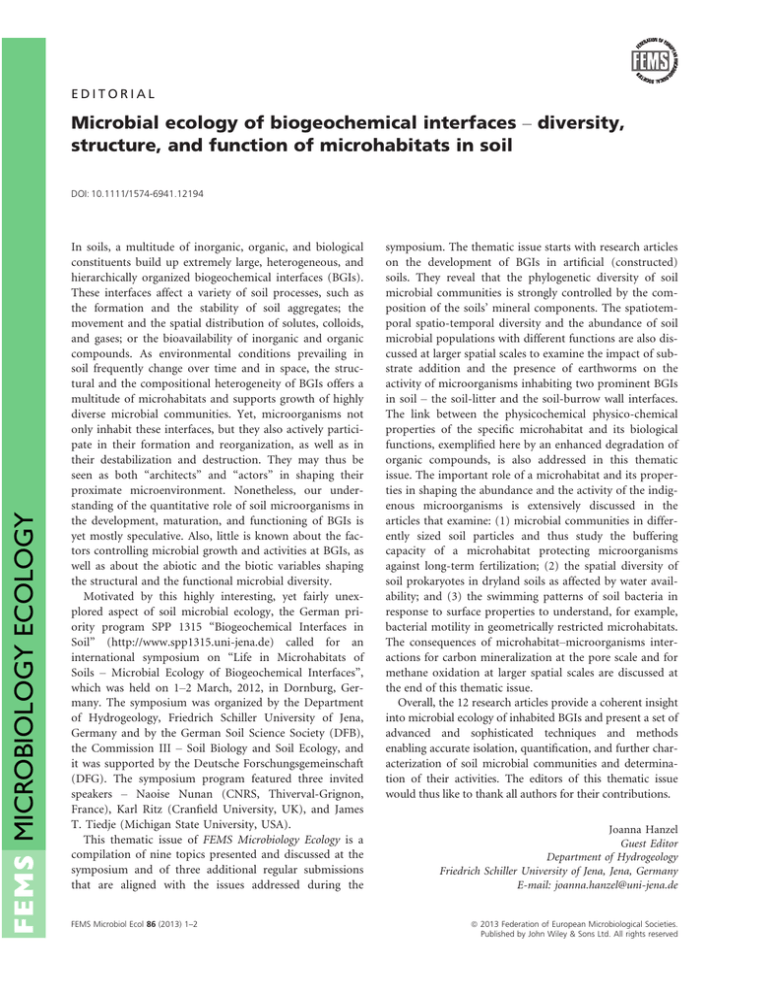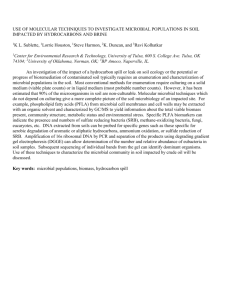
EDITORIAL
Microbial ecology of biogeochemical interfaces – diversity,
structure, and function of microhabitats in soil
MICROBIOLOGY ECOLOGY
DOI: 10.1111/1574-6941.12194
In soils, a multitude of inorganic, organic, and biological
constituents build up extremely large, heterogeneous, and
hierarchically organized biogeochemical interfaces (BGIs).
These interfaces affect a variety of soil processes, such as
the formation and the stability of soil aggregates; the
movement and the spatial distribution of solutes, colloids,
and gases; or the bioavailability of inorganic and organic
compounds. As environmental conditions prevailing in
soil frequently change over time and in space, the structural and the compositional heterogeneity of BGIs offers a
multitude of microhabitats and supports growth of highly
diverse microbial communities. Yet, microorganisms not
only inhabit these interfaces, but they also actively participate in their formation and reorganization, as well as in
their destabilization and destruction. They may thus be
seen as both “architects” and “actors” in shaping their
proximate microenvironment. Nonetheless, our understanding of the quantitative role of soil microorganisms in
the development, maturation, and functioning of BGIs is
yet mostly speculative. Also, little is known about the factors controlling microbial growth and activities at BGIs, as
well as about the abiotic and the biotic variables shaping
the structural and the functional microbial diversity.
Motivated by this highly interesting, yet fairly unexplored aspect of soil microbial ecology, the German priority program SPP 1315 “Biogeochemical Interfaces in
Soil” (http://www.spp1315.uni-jena.de) called for an
international symposium on “Life in Microhabitats of
Soils – Microbial Ecology of Biogeochemical Interfaces”,
which was held on 1–2 March, 2012, in Dornburg, Germany. The symposium was organized by the Department
of Hydrogeology, Friedrich Schiller University of Jena,
Germany and by the German Soil Science Society (DFB),
the Commission III – Soil Biology and Soil Ecology, and
it was supported by the Deutsche Forschungsgemeinschaft
(DFG). The symposium program featured three invited
speakers – Naoise Nunan (CNRS, Thiverval-Grignon,
France), Karl Ritz (Cranfield University, UK), and James
T. Tiedje (Michigan State University, USA).
This thematic issue of FEMS Microbiology Ecology is a
compilation of nine topics presented and discussed at the
symposium and of three additional regular submissions
that are aligned with the issues addressed during the
FEMS Microbiol Ecol 86 (2013) 1–2
symposium. The thematic issue starts with research articles
on the development of BGIs in artificial (constructed)
soils. They reveal that the phylogenetic diversity of soil
microbial communities is strongly controlled by the composition of the soils’ mineral components. The spatiotemporal spatio-temporal diversity and the abundance of soil
microbial populations with different functions are also discussed at larger spatial scales to examine the impact of substrate addition and the presence of earthworms on the
activity of microorganisms inhabiting two prominent BGIs
in soil – the soil-litter and the soil-burrow wall interfaces.
The link between the physicochemical physico-chemical
properties of the specific microhabitat and its biological
functions, exemplified here by an enhanced degradation of
organic compounds, is also addressed in this thematic
issue. The important role of a microhabitat and its properties in shaping the abundance and the activity of the indigenous microorganisms is extensively discussed in the
articles that examine: (1) microbial communities in differently sized soil particles and thus study the buffering
capacity of a microhabitat protecting microorganisms
against long-term fertilization; (2) the spatial diversity of
soil prokaryotes in dryland soils as affected by water availability; and (3) the swimming patterns of soil bacteria in
response to surface properties to understand, for example,
bacterial motility in geometrically restricted microhabitats.
The consequences of microhabitat–microorganisms interactions for carbon mineralization at the pore scale and for
methane oxidation at larger spatial scales are discussed at
the end of this thematic issue.
Overall, the 12 research articles provide a coherent insight
into microbial ecology of inhabited BGIs and present a set of
advanced and sophisticated techniques and methods
enabling accurate isolation, quantification, and further characterization of soil microbial communities and determination of their activities. The editors of this thematic issue
would thus like to thank all authors for their contributions.
Joanna Hanzel
Guest Editor
Department of Hydrogeology
Friedrich Schiller University of Jena, Jena, Germany
E-mail: joanna.hanzel@uni-jena.de
ª 2013 Federation of European Microbiological Societies.
Published by John Wiley & Sons Ltd. All rights reserved
2
Editorial
David Myrold
Guest Editor
Department of Crop and Soil Science
Oregon State University, Corvallis OR, USA
E-mail: david.myrold@oregonstate.edu
Angela Sessitsch
Guest Editor
Austrian Institute of Technology, Vienna, Austria
E-mail: angela.sessitsch@ait.ac.at
Kornelia Smalla
Guest Editor
Institute for Epidemiology and Pathogen Diagnostics
Julius K€
uhn-Institut – Federal Research Centre for Cultivated
Plants Braunschweig, Germany
E-mail: kornelia.smalla@jki.bund.de
ª 2013 Federation of European Microbiological Societies.
Published by John Wiley & Sons Ltd. All rights reserved
Christoph C. Tebbe
Guest Editor
Th€
unen Institute of Biodiversity
Federal Research Institute for Rural Areas, Forestry
and Fisheries
Braunschweig, Germany
E-mail: christoph.tebbe@ti.bund.de
Kai Uwe Totsche
Guest Editor
Department of Hydrogeology
Friedrich Schiller University of Jena, Jena, Germany
E-mail: kai.totsche@uni-jena.de
FEMS Microbiol Ecol 86 (2013) 1–2


